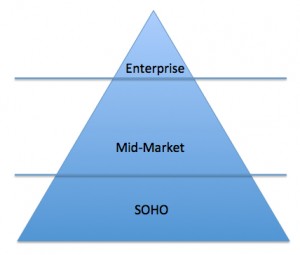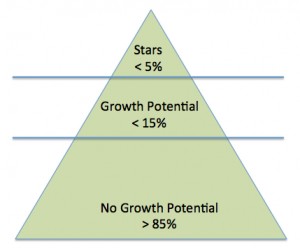Global growth through a partner channel in the software industry – Part 6: Partner Value Proposition (Leadership)
 In previous posts we discussed the issues related to building and managing a channel of partners in the Bootstrapping and Bridgehead stages of market penetration. This post discusses the issues and opportunities in the Leadership stage.
In previous posts we discussed the issues related to building and managing a channel of partners in the Bootstrapping and Bridgehead stages of market penetration. This post discusses the issues and opportunities in the Leadership stage.
Leadership
The characteristics of the Leadership stage are:
- You have your own representation in the most important locations
- You have Partners in all locations
- You have reference customers in all locations
- Your brand recognition is >90% in your key market segment(s)
- You are profitable and have a healthy balance sheet
- Adding more Partners will (ceteris paribus) lead to increased channel competition
While potential channel competition may work against you in the Bootstrapping and the early Bridgehead stages, it will to a certain extent work in your favor in the Leadership stage. While new potential partners will be reluctant to sign up with you in the Bootstrapping and Bridgehead stages, the situation is exactly the opposite in the Leadership stage. Demand for and market recognition of your solution will make potential partners want to sign up to get a share of that demand.
Channel competition
As an ISV you deliberately want to ensure a certain degree of channel competition. It is to your advantage that the customers have a choice of partner. However, there is no point in having too much partner capacity addressing the same market segments. In the Leadership stage you will work on extending your market reach by recruiting Partners who have the potential of covering “white space” in the market – space where you are currently not represented.
The four dimensions
Any software company works with four market dimensions:
- Domain (industry)
- Solution portfolio (products and services)
- Size of customer
- Geography
Most growth strategies maintain a narrow focus on Domain, Solution, and Size-of-customer while expanding geographically. Scaling a business with a narrow focus is obviously much more simple and effective than playing simultaneously on all four dimensions.
In the Leadership stage you will have saturated the geographic dimension, meaning that you have to expand along one or more of the other dimensions.
Domain

A vertical focus is an excellent way to get market access
There obviously are solutions, which are genuinely horizontal. Nevertheless most solutions do become more relevant and valuable to the customers when adapted to address [slider title=”vertical”] A vertical sales and marketing approach with a horizontal product/service will initially yield better results than shooting in all directions. [/slider] industry challenges.
In post #2 in this series we touched on the nature of your product. Is it a standard product or is it designed for a partner channel? Products designed for a channel of Value Added Partners will provide differentiation opportunities for the Partners beyond what the standard product can provide. However, even standard products can benefit from a vertical partner focus.
In both situations you will have a strong incentive to recruit, push and assist partners applying a vertical market focus. Motivating you partners to apply a vertical focus will enable you to recruit many more partners without just adding fuel to channel competition. It will also enable you to remain competitive vis-a-vis your competitors.
You can help your partners by introducing certification or other types of vendor endorsement of the skills and solution elements the partners add to become more relevant to their potential customers.
Solution portfolio
Expanding the solution [slider title=”portfolio”] selling new complementary product and services to new and existing customers through existing Partners [/slider] is also an approach which many ISV’s take to maintain growth. This path is not as easy as it sounds. There is a learning curve associated with complementary products and services. The learning curve applies to the vendor as well as to the partners. Extending the portfolio requires substantial investment from the ISV ensuring that the entire value chain is capable of delivering solutions to the customers.
A solution platform, which allows for Partner extension, will automatically grow the customer “share of wallet” as Partners develop proprietary extensions. The Partners will have be strongly motivated to increase their proprietary extension as it improves their margin and strengthens their differentiation vis-a-vis other Partners. This approach may develop into a self-supporting eco-system, which is benefiting from network and tornado effects.
Size of customer

Fig. 1. Market Pyramid
Most products appeal to a certain segment of the market. This appeal to a certain segment can have it’s’ roots in technical issues, such as performance and functionality, but can also be purely based on branding efforts or de facto historical positioning.
Experience has shown that it is extremely difficult to move software products up and down in the market pyramid. Using a Partner channel adds to the rigidity of product movement in the market pyramid. Partners are typically recognized for and experienced with serving certain segments of the market. You need specific partners to serve the various market segments.
Especially serving the upper Mid-Market and the Enterprise segments through a Partner has channel has proven extremely difficult.
ISVs planning to grow for market dominance must explore ways to serve the entire market Pyramid. If they ignore certain segments of the market, they risk being attacked by competitors from “below” and from “above”.
Geography
We have already addressed the geographical dimension. This is the first and most obvious growth dimension. Dominance requires expanding beyond the geographical dimension.
The Partner Challenge

Fig. 2: Partner Pyramid
All ISVs working from Bridgehead towards Leadership face a common challenge: The growth capability of their individual Partners.
The Partner channel landscape can be divided into three categories:
Stars
The Stars are Partners with ambitions and skills to grow to become major companies in their own right. They will grow independently of all the support programs that the ISV may offer.
There are not many Stars in the partner channel.
Stars need continuous top executive support from the ISV or they may fuel their growth from competitive sources.
Growth potential
Some Partners do have growth potential, but need executive management support to release the potential. These Partners do have the ambitions, but somehow lack the management drive to transform the intentions to growth. Targeted ISV management support programs may release the embedded energy in these companies.
The support needed cannot be provided by the average channel partner manager. They need support from executives who have experience with growing companies and understand the challenges and issues associated with growing a business.
No growth potential
Most of the Partners in the channel lack either the ambitions or the skills to grow their business beyond a certain size. The growth issues are typically related to the founder/owner of the company, who cannot delegate or are otherwise unable to attract and keep the staff required to take the company from infancy to adolescence.
The Growth Challenge
The Partner Value Proposition in the Leadership stage is completely different from the Partner Value Proposition in the Bootstrapping and Bridgehead stages.
In the Leadership stage you are way beyond “proof of concept and value”. You are working from a position of strength, which is nice but also potentially dangerous.
Your biggest challenge in the process of growing from the bridgehead to leadership is the lack of new qualified partners, the limited growth potential of the current partners and the potential arrogance of your own people.
Standardization

The established software company does not recruit cowboys, but rather horsemen who can hold the line.
As you move from fighting to bootstrap and build bridgeheads to having a large installed base of customers and an established partner network your own organization will change too. From being an agile entrepreneurial ISV you will become an established organization with a brand profile, hierarchy, policies and procedures and internal political agendas.
The people who started the company will either have moved to the top of the organization or be gone. You will now recruit people who shall manage your established programs and do incremental adjustments, which can be applied across the entire partner channel. You will now have Partner Recruitment Managers and Partner Account Managers, who never started their own business and who do not really have the skills and experience required to help their partners grow. They may be able to manage, but they cannot lead.
All major software-driven companies are facing these challenges. All their partners are SMB’s with the same type of growth issues. The ISV herself is an enterprise with completely different issues and agendas. From a business leadership and management perspective you can hardly think of businesses which are more different.
The dwarf and the giant
Let me finish this post with a few observations and recommendations.
- You and your partners have completely different strategic DNA. You will be product leadership driven – your partners will be customer intimacy driven.
- If you are a software company working on building a partner channel then don’t look to the big guys for inspiration. They are on a different planet and are working a complete different agenda from the one that you need.
- Focus on customers first and understand what it takes to find them, win them and keep them happy.
- Work with the partners to make them successful.
- Understand that your partners are NOT your customers. Your partners are a part of your value chain.
- Your partners are running a business. They have limited resources available to invest in bringing your product to the market. Help them with the learning curve and with winning the first customers.
- Partners are impatient. Don’t expect them to keep up the momentum if tangible results do not materialize within the first 6 months.
- Ask your partners for the same level of commitment as you are providing yourself. Dedicated resources and focus is needed to grow any business.
About this series of blog posts on “Global growth through a partner channel in the software industry”
An associate of mine once concluded: If you have enough money: Go direct. If you have enough time: Build a channel.
My associate had been spearheading the development of one of the most successful VAR channels in the world. This channel now belongs to Microsoft and is branded Dynamics.
This series of posts will discuss the issues associated with using a channel based Go-To-Market approach on the path to global market leadership for Independent Software Vendors.
Few success stories and numerous failures
Using a channel of independent companies to resell, implement and/or service customers has a long tradition in the history of the software industry. For some software companies, the channel has been a major contributor to global success, but for most software companies making it work is a depressing and constant struggle.
The word “channel” is used in the software industry to describe independent companies that assume various roles and obligations in bringing a software product to the customers. The definition is rather broad, since the roles and obligations can vary substantially from “simple” reselling to system integration, solution development on top of the software, implementation in terms of consulting, project management, customization, training and support.
The common denominator is the fundamental condition that the individual channel operator is an independent contractor operating in his own name, at his own expense and at his own risk.
Other post in this series
Post #1: For all the wrong reasons
Post #2: For all the right reasons
Post #3: The three stages of market penetration
Post #4: The Partner Value Proposition (bootstrapping)
Post #5: The Partner Value Proposition (bridgehead)







